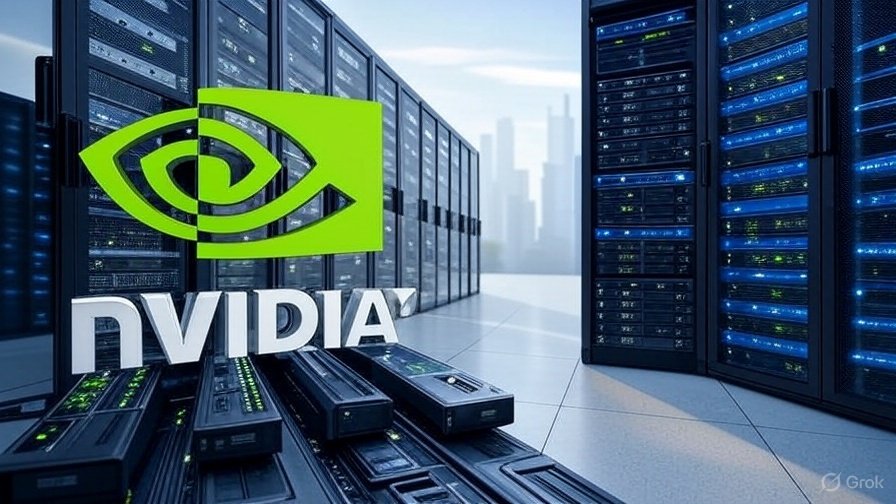
As we navigate mid-2025, Nvidia (NVDA) is stealing the spotlight with its market value soaring to $3.5 trillion, sparking intense speculation about whether 2025 will indeed be the year it breaches the coveted $5 trillion mark. As a frontrunner in the AI revolution with its groundbreaking GPUs, Nvidia has eclipsed tech giants like Apple and Microsoft, fueled by a 300% revenue surge since 2023 and the game-changing Blackwell GPU architecture. With analysts predicting a potential 47% stock rise to hit this milestone—supported by robust AI demand and emerging quantum computing opportunities—the answer leans toward yes, provided it navigates current challenges. Let’s explore the driving forces and risks shaping this pivotal moment for investors in today’s dynamic tech landscape.
AI Surge Powers Nvidia’s Ascent
Nvidia’s remarkable rise stems from a staggering revenue jump of over 300% since 2023, driven by the skyrocketing need for AI infrastructure. The introduction of the Blackwell GPU architecture, boasting up to 25 times greater efficiency than earlier models, has cemented Nvidia’s stronghold in data centers and AI-driven industries. Major tech players such as Meta, Amazon, and Microsoft are heavily investing in AI, with forecasts predicting Nvidia’s data center earnings could soar to $145 billion by year-end 2025. This growth path positions the company for a potential 47% stock surge from its current $3.5 trillion valuation, bringing the $5 trillion goal within reach.
Market Buzz and Bold Predictions
The financial world is abuzz with excitement, and Nvidia is a hot topic on X. Experts highlight the company’s anticipated 51% revenue growth and 50% earnings-per-share boost for fiscal 2026, covering much of 2025. A recent Barclays analysis set a new price target at $200, suggesting a possible 38% gain that could edge the market cap toward $4.9 trillion. Some analysts are even more optimistic, envisioning a $5.6 trillion valuation by late 2025 if Blackwell continues to gain traction. This positive sentiment reflects Nvidia’s pivotal role in shaping the future of AI technology.
Obstacles to Overcome
The road to $5 trillion isn’t without bumps. New export restrictions on Nvidia’s H20 products to China, a key market, might trim growth by around $8 billion in 2025. Geopolitical uncertainties and rising competition from AMD and Chinese chip developers add pressure. A market downturn, like the one experienced earlier this year, could also test Nvidia’s stability. Still, its commanding 80%+ share in the AI chip sector and a versatile ecosystem like CUDA provide a strong buffer, hinting that these hurdles may be short-lived.
Quantum Computing’s Role in Nvidia’s Future and AI Evolution
The emergence of quantum computing is adding a new layer to Nvidia’s story. Quantum technology, using qubits to tackle complex calculations at unprecedented speeds, could transform AI by solving optimization challenges and training advanced models. For Nvidia, this presents both opportunities and risks. On the upside, Nvidia is forging partnerships with quantum hardware innovators and developing tools to integrate its GPUs into hybrid quantum-classical systems. This strategic move could unlock fresh revenue channels, potentially accelerating its climb to a $5 trillion valuation if it secures a foothold in this cutting-edge field.
On the downside, fully functional quantum computers might outpace traditional GPUs in specific AI tasks, such as molecular simulations or encryption, potentially reducing demand for Nvidia’s hardware. Competitors like IBM and Google, advancing their quantum projects, could introduce specialized processors, challenging Nvidia’s lead. While widespread quantum AI adoption is likely 5-10 years away, the AI landscape might shift toward hybrid solutions where Nvidia’s GPUs play a supporting role. This uncertainty could either bolster or hinder its growth, depending on how quickly quantum tech matures.
Why the $5 Trillion Mark Matters
Hitting $5 trillion would crown Nvidia as the first company to achieve this feat, eclipsing Apple’s highest valuation. For investors, this milestone signals a stock with the potential for transformative returns—imagine turning a $1,000 investment from 2015 into over $50,000 today. It also highlights AI’s transformative potential, further amplified by quantum advancements, positioning Nvidia as a key player in the next computing era.
What’s Next for Investors?
With sustained growth and a smart approach to quantum opportunities, Nvidia could reach a $5 trillion market cap by late 2025 or early 2026. Stay updated on quarterly earnings, Blackwell’s market penetration, global AI investments, and quantum collaborations. Balancing your portfolio with a stake in this AI pioneer could optimize risk and reward. As the tech world evolves with quantum influences, Nvidia’s journey remains a must-watch—could 2025 redefine its market dominance?






